(1) Platform Addition
Platform Addition refers to whether the Raft/Brim/Skirt needs to be added or not, there are six options in all.
The None refers to not printing Raft/Brim/Skirt for model.
The Skirt is loop(s) of plastic extruded around the first layer of the model to ensure a steady flow for model.
The Raft is composed by a few layers placed on the printing surface before the model is printed to help a model stick to the printing surface.
The Brim layer will only print a single layer placed on the first layer of the model which allow for better adhesion to the printing surface.

Figure 1: Select a structure for "Platform Addition".
(2) Raft
Note: It will only exist when the platform addition is set as Raft only or Raft and Skirt or Raft and Brim.
Raft Extruder refers to selecting which extruder to print raft. (If you have set number of extruders to be 1, then it will only show Primary Extruder; if you have set it to be 2, then it will show Left Extruder and you can switch to Right Extruder).
Raft Offset refers to the distance between the model and extra raft area around it.
Raft Gap from Model refers to the gap between the last layer of the raft and the first layer of model.
Second Layer Z Lift with this function enabled, the model’s second layer will be lifted. It will be easier to remove the model from the raft.
Note: Please don’t set the Second Layer Z Lift too large, or it may cause gaps between the first layer and second layer.

Figure 2: Set "Raft Lines Type" to be 0.5mm.
Raft Lines Type refers to infill pattern for the raft.
Lines refer to the segments at the same direction.
Rectilinear refers to the fill structure printed with a continuous moving path.

Figure 3: Select a Raft Lines Type for your model.
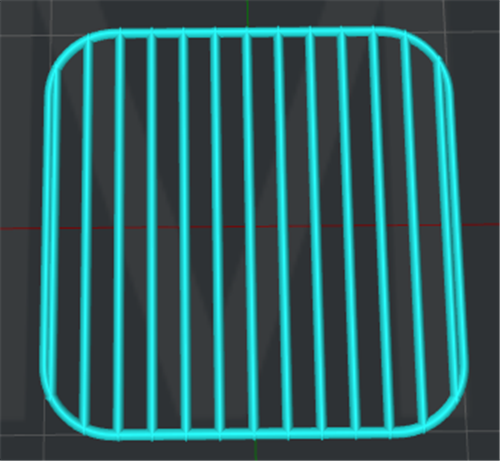
Figure 4: "Raft Lines Type" set to "Lines".

Figure 5: "Raft Lines Type" set to "Rectilinear".
Keep Holes in raft structure refers to generating the raft with holes inside according to the shape of your model. With being unchecked, there will be generating a whole piece of Raft without holes inside in case overlapping lines between different printing sections on Raft.
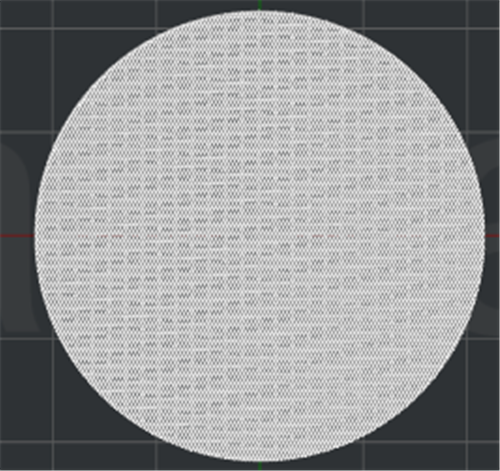
Figure 6: Normal Raft.

Figure 7: Keep holes in Raft structure.
First Layer refers to the number of layers as the base layers of the raft.
First Layer Speed refers to the printing speed for the first layers of the raft.
Extrusion Width Percentage refers to the percentage of extrusion width in raft first layers. For Example, if the extrusion width is 0.4 mm, and you set this value to be 120% then the raft first layer extrusion width will be 0.48mm.
Layer Height refers to the thickness of raft first layer.
First Layer Infill Ratio refers to the infill density for the first layers of the raft.
First Layer Infill Angle refers to the infill angle for the first layers of the raft.
Middle Layer refers to the number of middle layers at the middle of the raft.
Middle Layer Speed refers to the printing speed for the middle layers of the raft.
Extrusion Width Percentage refers to the percentage of extrusion width in raft surface layers. For Example, if the extrusion width is 0.4 mm and you set this value to be 120% then the raft middle layer extrusion width will be 0.48mm.
Layer Height refers to the thickness of raft middle layer.
Middle Layer Infill Ratio refers to the infill density for the middle layers of the raft.
Middle Layer Infill Angle refers to the infill angle for the middle layers of the raft.
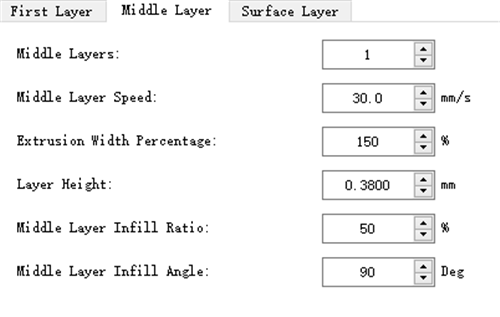
Figure 8: Raft Middle Layer.
Surface Layers refers to the number of surface layers at the top of the raft.
Surface Layer Speed refers to the printing speed for the surface layers of the raft.
Extrusion Width Percentage refers to the percentage of extrusion width in raft surface layers. For Example, if the extrusion width is 0.4 mm and you set this value to be 120% then the raft surface layer extrusion width will be 0.48mm.
Layer Height refers to the thickness of raft surface layer.
Surface Layer Infill Ratio refers to the infill density for the surface layers of the raft.
Surface Layer Infill Angle refers to the infill angle for the surface layers of the raft.
Surface Layer Flowrate refers to the setting the Flowrate at the raft surface layer. Flowrate refers to how much plastic the printer is told to extruder.
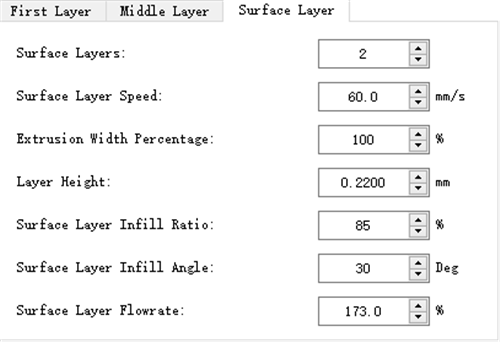
Figure 9: Raft Surface Layer.
(3) Skirt and Brim
Note: It will only exist when the platform addition is set to be Skirt only or Raft and Brim.
Skirt /Brim Extruder refers to selecting an extruder for skirt or brim part. (If you have set number of extruders to be 1, then it will only show Primary Extruder; if you have set it to be 2, then it will show Left Extruder and you can switch to Right Extruder).

Figure 10: "Skirt Loop Lines" set to 2.
Skirt /Brim Speed refers to the printing speed for the Skirt/Brim.
Skirt /Brim Minimal Length refers to the minimal length of Skirt/Brim. If The total length of Skirt or Brim is less than Skirt /Brim Minimal Length, then ideaMaker will add more Loops until the result length is longer than Skirt /Brim Minimal Length.
Skirt Loop Lines refers to the number of skirt loops.
Skirt Offset Distance refers to the distance between skirt and model.

Figure 11: "Skirt Offset Distance" set to 5mm.
Skirt- Print Outer Shell Before Inner Shell in the First Layer refers that with this function enabled, if you set Platform Additions to Skirt only, ideaMaker will print outer shell first before inner shells in the first layer.
Brim Loop Lines:
Note: It will only exist when the platform addition is set to be Brim only or Raft and Brim.
Brim Loop Lines refers to the number of brim circle.

Figure 12: "Brim Loop Lines" set to 4.
Print Outer Shell Before Inner Shell in the First Layer refers that with this function enabled, software will print outer shell first if you set Platform Additions to be Brim only.
Brim-Print Outer Shell Before Inner Shell in the First Layer refers that with this function enabled, if you set Platform Additions to Brim only, ideaMaker will print outer shell first before inner shells in the first layer.
Add Brim on Internal Regions refers that with this function enabled, software will print Brim if there are some holes on the inner of models or internal islands like support structures and small models placed in the large model.
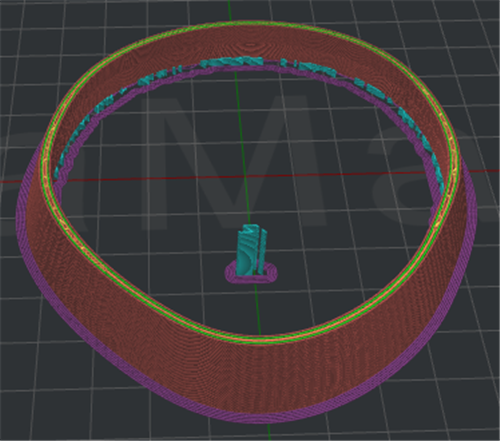
Figure 13: "Add Brim on Internal Regions" function enabled

Figure 14: "Add Brim on Internal Regions" function disabled
Raft Overrides - with this function enabled, the below settings will be used to override settings in slicing templates when raft is enabled.
Press "+" to add more settings as shown in Figure 15.
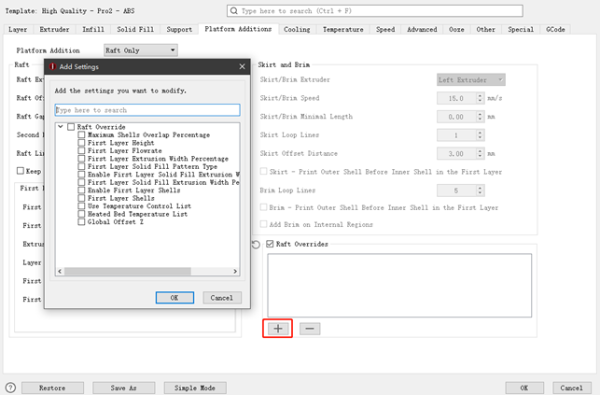
Figure 15: Raft Overrides settings.
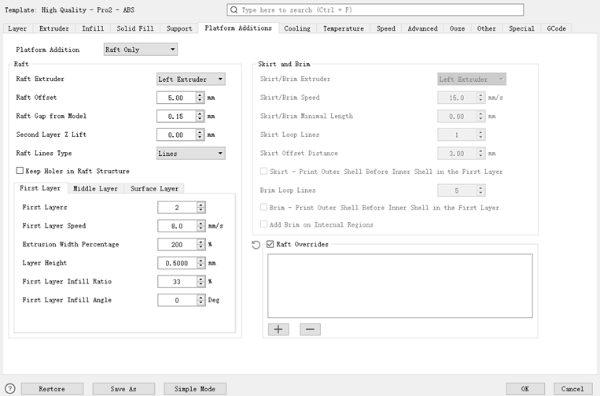
Figure 16: The Platform Additional Tab.
-END-